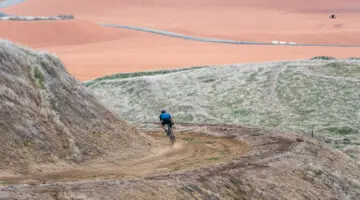Now that the proverbial and literal dust of the Kansas plains has settled after the Dirty Kanza 200, the attention of the gravel racing world moves west to southwest Utah for the Crusher in the Tushar. Whereas the Dirty Kanza was an epic slog of attrition through the rolling hills of Kansas, the Crusher has a bit different of a vibe with two major climbs, high elevations and a mixture of gravel and pavement.
The seventh edition of the Crusher in the Tushar is being held on Saturday, July 8. Today we take a brief look at the Crusher in the Tushar course and what gravel fans can expect from the impressive list of women and men professional riders looking to grind the gravel on Saturday.
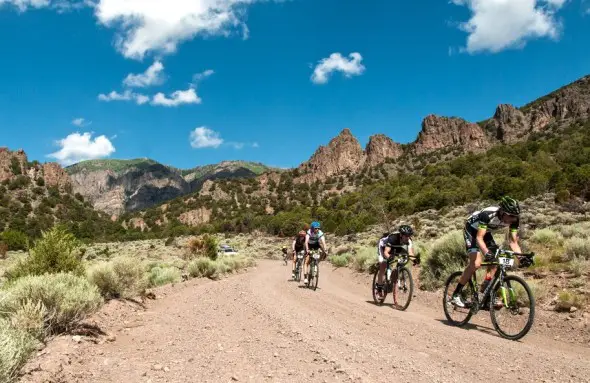
The Crusher in the Tushar is known for its seemingly never-ending gravel climbs and sweeping views. © Chris See
Climbing and Beautiful Views Await on the Crusher Route
The Tushar Mountain range is the third-highest mountain range in the state of Utah, with the highest peak at 12,174 feet. (The highest, the Uinta range got a brewery named after it. Not sure what the honor for the second-highest La Sal range is.)
The event was created by Burke Swindlehurst in 2011, who still has the same passion for the event seven years later as the race director. If you missed it, check out Daniel Curtin’s interview with Burke from last year.
The Crusher in the Tushar route is 69 miles long with nearly 10,000 feet of elevation gain and 6,000 of descent. The race starts at an elevation of 5,900 feet in the town of Beaver and finishes above 10,500 at the Eagle Point resort, so in addition to the climbing, riders also have to deal with the effects of elevation while they are heading up the long ascents.
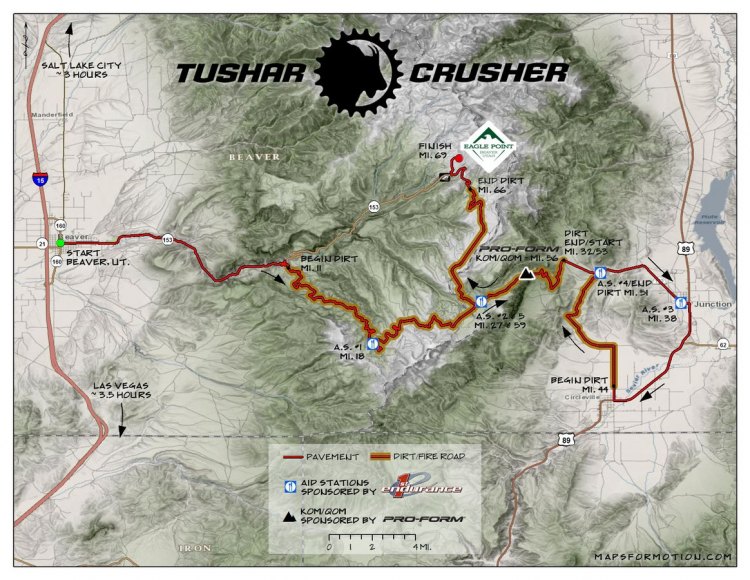
The 2017 Crusher in the Tushar features over 10,000 of elevation gain on a route that heads into the Tushar Mountains of Utah. (photo: Crusher in the Tushar)
The Crusher route departs from Beaver, Utah and quickly heads up into the mountains. The first climb starts almost immediately and ascends over 4,000 feet in the first 23 miles of the race. The first third of the climb is on pavement, but around mile nine riders head off the tarmac and onto a dirt fire road for the last 2,900 feet to the top of the first summit.
Physics is not necessarily my strong suit, but I am pretty sure what goes up must eventually come down. At this junction of the Crusher route, the coming down is a 14-mile, 4,000-foot descent mostly along the dirt fire road. After rolling through the town of Junction, riders get a bit of a respite before heading back into the clouds toward the finish.
Beginning around Mile 51 is the famed Col d’Crush gravel road climb. The 2,300 foot Col d’Crush climb finishes with the Pro-Form QOM/KOM awarded to the first woman/man to reach the top of the intermediate ascent.
After the QOM/KOM, the ride heads to the finishing climb up to the Eagle Point ski resort. The last climb at 10,000 feet of elevation averages 8% and kicks up over 11% into the finish line.
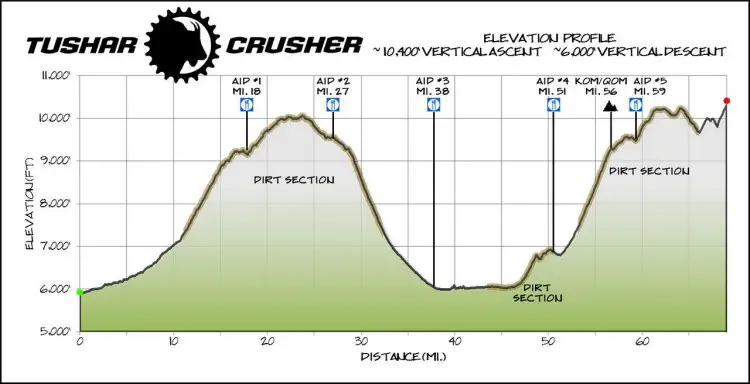
The Crusher in the Tushar route features two major climbs, including the famed Col d’Crush. (photo: Crusher in the Tushar)
They’re Not Players, They Just Col d’Crush A Lot
In addition to its mystique, the Crusher in the Tushar also provides a decent payday to the winners, with the top woman and man receiving $1,000. The QOM/KOM climb has a nice payout as well. The combination of the challenge and the lucre helps bring impressive fields out to the Utah mountains.
As it has in previous years, the 2017 Women’s field features a number of accomplished riders. 2016 winner, and course record holder, Mindy McCutcheon is back to go for two wins in a row. She will have her hands full though, with 2015 winner Robin Farina and 2015 runner-up Mindy Caruso also making the start. The trio has shared the podium the last two years, which means there is the possibility of another permutation of the Mindy-Mindy-Robin podium in 2017.
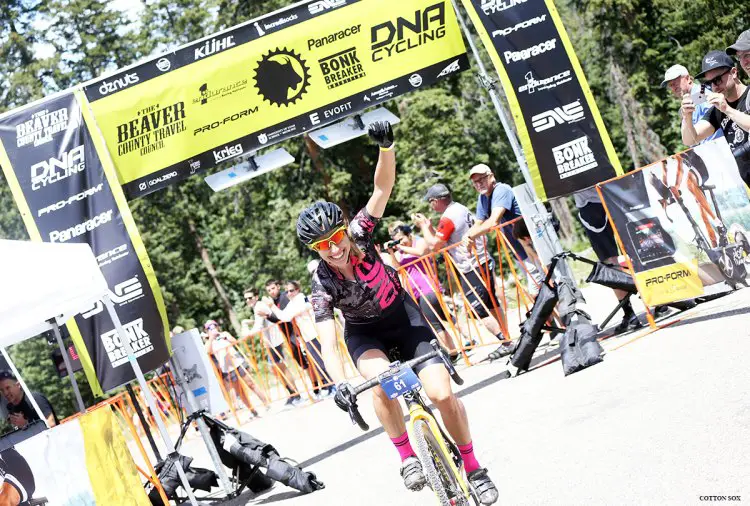
Mindy McCutcheon set a course record of 4:53:16 while winning the 2016 event. 2016 Tushar Crusher. Photo courtesy Catherine Fegan-Kim (Cotton Sox Photography)
Gravel star Amanda Nauman chipped in her pick to click, Larissa Connors, winner of the 2017 Belgian Waffle Ride held near San Diego. (Not to be confused with the Donut Race, obviously)
You should add BWR Champ @Larissa_Connors to that list of podium contenders! My pick to win! @tusharcrusher
— Amanda Nauman (@_amanda_panda_) July 7, 2017
On the men’s side, Robbie Squire of (appropriately) Sandy, Utah has been on an absolute tear at the Crusher. Squire won by over eight minutes in 2016 and 12 minutes in 2015. At the top of the list of those looking to deny Squire the three-peat is DK200 winner Mat Stephens, who has been crushing the gravel scene this year. DK200 runner-up Jake Wells is also no stranger to riding hills at elevation, so he is also one to look out for as well.
Although Cyclocross Magazine strives to be an unbiased publication, I think it is fair to say cheering for Jamey Driscoll at the Crusher is not out of order. Driscoll has finished second at the event twice, finished second at Cyclocross Nationals in Hartford and finished second at Fat Bike Nationals earlier this year. I think it is fair to say Driscoll is due for a victory.
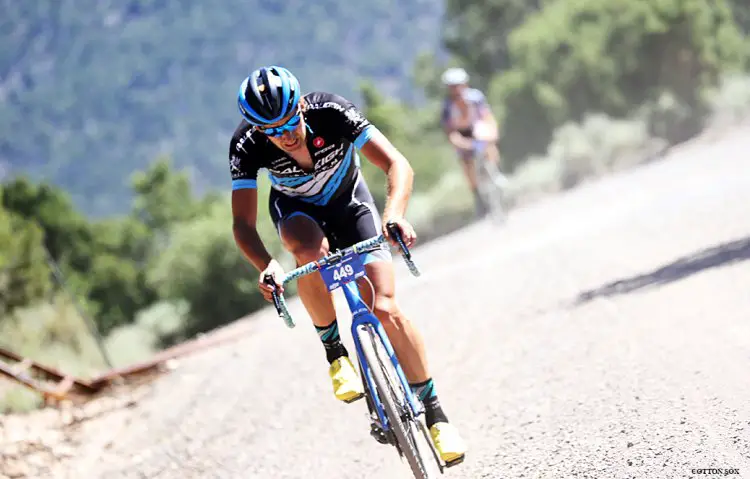
Jamey Driscoll has finished second at the Crusher in the Tushar twice. 2016 Tushar Crusher. Photo courtesy Catherine Fegan-Kim (Cotton Sox Photography)
Other familiar names looking to crush it in the Tushar are DK200 third-place finisher Menso de Jong, Allen Krughoff and Todd Wells.
Stay tuned for full coverage from the 2017 Crusher in the Tushar. In the meantime, check out this cool video from the 2013 event to see what riders are in for. (Pretty sure there was a nice ’cross outrigger in there. So pro.)

